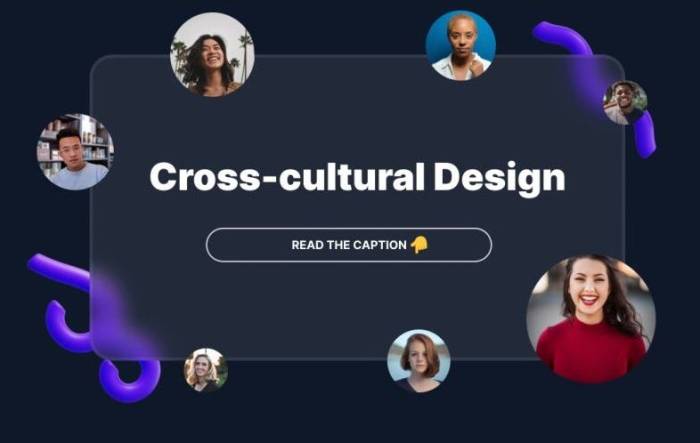Designing for a global audience requires more than just translating text; it demands a deep understanding of cultural nuances. This exploration delves into five creative approaches to design, showcasing how to effectively adapt visuals, symbolism, and user interfaces to resonate with diverse cultural backgrounds. We’ll examine how seemingly small design choices can significantly impact consumer perception and engagement across different markets.
From understanding color palettes and symbolism to adapting website layouts and mobile app interfaces, we’ll cover practical strategies and real-world examples to illustrate the importance of cultural sensitivity in successful design projects. This isn’t simply about avoiding offense; it’s about creating designs that are not only aesthetically pleasing but also deeply meaningful and relevant to the target audience.
Understanding Cultural Nuances in Design

Effective design transcends language barriers, but it must resonate with the cultural context of its intended audience. Ignoring cultural nuances can lead to misinterpretations, offense, and ultimately, design failure. Understanding and incorporating cultural sensitivities is crucial for creating designs that are not only aesthetically pleasing but also culturally appropriate and effective.
Logo Design Reflecting Cultural Values
The visual language of logos powerfully communicates a brand’s identity. Designing logos that effectively represent different cultures requires a deep understanding of their respective values and aesthetics. The following table showcases examples of logos reflecting contrasting cultural values:
| Culture | Logo Description | Cultural Influence |
|---|---|---|
| Japanese | A simple, elegant logo featuring a stylized Mount Fuji silhouette, rendered in subtle shades of grey and black. The lines are clean and minimal. | Emphasizes minimalism, simplicity, and natural beauty, reflecting traditional Japanese aesthetics. |
| Brazilian | A vibrant logo incorporating bright, bold colors like yellow, green, and blue, with dynamic, flowing lines suggesting movement and energy. It might feature stylized depictions of tropical flora or fauna. | Reflects the country’s exuberant spirit, biodiversity, and Carnival celebrations. |
| Moroccan | A logo using intricate geometric patterns inspired by Islamic art, incorporating rich jewel tones like deep reds, golds, and blues. The design might include arabesque motifs. | Emphasizes tradition, craftsmanship, and rich history, reflective of Moroccan artistic heritage. |
Color Palette Comparisons Across Cultures
Color holds significant symbolic meaning across cultures, impacting consumer perception and brand associations. Understanding these cultural color associations is paramount for effective design.
Color palettes commonly associated with three distinct cultures:
The use of color in design varies significantly across cultures. For example, while white symbolizes purity and mourning in some cultures, it represents celebration and joy in others. Similarly, the significance of red can range from good luck to danger depending on the cultural context.
- Japanese: Often utilizes a muted palette with emphasis on natural tones such as earthy browns, greens, and blues, reflecting a preference for understated elegance and harmony with nature.
- White: Purity, simplicity
- Black: Sophistication, formality
- Red: Good fortune, celebration
- Green: Nature, peace
- Indian: Frequently employs a rich and vibrant palette, incorporating bright colors like saffron, orange, red, and gold, which often represent spirituality, prosperity, and festivity.
- Red: Purity, fertility, auspiciousness
- Yellow: Prosperity, knowledge
- Orange: Courage, enthusiasm
- Green: Growth, prosperity
- American: Favors a diverse range of color palettes, often reflecting the country’s multicultural nature. However, certain colors like blue (trust, stability) and red (energy, passion) hold significant prominence.
- Red: Energy, passion, excitement
- White: Purity, innocence
- Blue: Trust, stability, security
- Green: Growth, nature, renewal
Symbolism in Cross-Cultural Design
Symbolism plays a crucial role in how consumers perceive and interpret designs. A symbol that holds positive connotations in one culture might have a negative or neutral meaning in another. Therefore, understanding the cultural significance of symbols is vital for creating designs that resonate positively with the target audience.
For example, the number 4 is considered lucky in some Asian cultures but unlucky in others. Similarly, the color white symbolizes purity in many Western cultures but is associated with mourning in some Asian cultures. These variations necessitate careful consideration when selecting symbols and colors in cross-cultural design. Failure to understand these nuances can result in designs that are misinterpreted or even offensive. The use of culturally appropriate imagery is crucial for building trust and positive brand associations. For instance, a design incorporating a lotus flower, a symbol of purity and enlightenment in many Asian cultures, would resonate strongly with audiences in those regions. Conversely, using a symbol considered taboo or negative in a particular culture can severely damage a brand’s reputation.
Adapting Design Principles for Global Audiences

Adapting design principles for global audiences requires a deep understanding of cultural nuances and preferences. Successful global design transcends mere translation; it involves thoughtful consideration of visual elements, user behavior, and cultural sensitivities to create resonant and effective experiences across diverse markets. Ignoring these factors can lead to misinterpretations, offense, and ultimately, failure to connect with the target audience.
Website Design Adaptations for Different Cultural Markets
The following table illustrates how a website promoting a fictional sustainable coffee brand, “Bean There, Done That,” might be adapted for two distinct cultural markets: the United States and Japan. The key differences highlight the importance of considering visual aesthetics, language, and overall user experience.
| Feature | United States Website | Japan Website |
|---|---|---|
| Layout | Linear, left-to-right flow, emphasis on clear calls to action (e.g., “Shop Now,” “Learn More”). Uses a grid-based layout for a clean and organized feel. | More emphasis on visual storytelling and imagery. A less rigidly structured layout, possibly incorporating asymmetrical design elements. Calls to action might be more subtle and integrated within the visual flow. |
| Imagery | Bright, bold photography showcasing coffee beans, happy people enjoying coffee in various settings (e.g., cafes, homes). Focus on individualistic enjoyment. | More emphasis on natural imagery, potentially featuring landscapes or traditional Japanese elements alongside the coffee. Focus on harmony and community. May incorporate softer, more muted colors. |
| Language | Direct, concise language emphasizing product benefits and convenience. Uses active voice and clear messaging. | More polite and indirect language. Emphasis on building trust and relationships with customers. May utilize honorifics and indirect communication styles. |
Typography and Language Direction in Website Design
Typography and language direction are crucial considerations for creating inclusive websites. Left-to-right (LTR) languages, like English, are the norm for many Western websites. However, right-to-left (RTL) languages, such as Arabic and Hebrew, require a complete reversal of the layout and text flow.
Effective solutions for LTR languages include using clear and legible fonts, ensuring sufficient spacing between lines and characters for readability, and employing a consistent visual hierarchy to guide the user’s eye. For RTL languages, mirroring the entire layout, including menus, buttons, and images, is essential. Using fonts designed specifically for RTL languages ensures proper character rendering and kerning. For example, a website designed for an Arabic-speaking audience would have its navigation menu appear on the right side of the screen, with text flowing from right to left. Careful consideration must be given to the positioning of images and other visual elements to maintain a natural and intuitive flow.
Mobile App UI Design for a Specific Culture
This section details the design of a mobile banking app for users in India, focusing on specific cultural needs and preferences.
The app design prioritizes ease of use for a diverse user base with varying levels of technological literacy. It incorporates features such as multiple language support (Hindi, English, and regional languages), simplified navigation, and large, easily tappable buttons. Visual elements are chosen to be familiar and appealing to the Indian market, possibly incorporating traditional patterns or color schemes while maintaining a modern and clean aesthetic.
- Simplified Navigation: The app utilizes a straightforward, intuitive menu structure with minimal nested screens to reduce cognitive load.
- Multilingual Support: The app supports multiple languages, allowing users to select their preferred language for a personalized experience.
- Accessibility Features: Large font sizes, high contrast colors, and voice-over support cater to users with visual impairments.
- Offline Functionality: Limited offline functionality allows users to access basic account information even without an internet connection, a crucial feature in areas with unreliable network coverage.
- Biometric Authentication: Integration of fingerprint or facial recognition enhances security and convenience.
Creative Applications of Cultural Insights in Design Projects

Integrating cultural insights into design isn’t merely about adding decorative elements; it’s about creating resonant and meaningful experiences for diverse audiences. By understanding and respecting cultural nuances, designers can craft projects that not only look beautiful but also communicate effectively and build genuine connections. This section explores how cultural insights can be creatively applied to elevate design projects.
Successfully incorporating cultural elements requires a delicate balance between authenticity and avoiding cultural appropriation. It demands thorough research, sensitivity, and a collaborative approach with individuals from the relevant culture. The goal isn’t to simply “borrow” elements, but to thoughtfully integrate them in a way that respects their original context and meaning.
Incorporating Traditional Art Forms and Cultural Motifs
Incorporating traditional art forms and cultural motifs into modern design requires careful consideration and a deep understanding of the cultural context. The process involves extensive research to understand the symbolism and meaning behind the chosen elements. This ensures that the integration is respectful and avoids misrepresentation.
“The key is not just visual representation, but understanding the narrative and emotional resonance associated with the chosen motifs.”
For example, a clothing brand might incorporate traditional textile patterns from a specific region. The design process would involve collaborating with artisans from that region, learning about the techniques and stories behind the patterns, and then thoughtfully adapting them to create contemporary designs. This ensures both authenticity and a modern aesthetic appeal. Similarly, a website design could incorporate traditional calligraphy styles, but only after careful consideration of readability and the overall design aesthetic. The choice of font, color palette, and overall layout would need to complement the calligraphy, not overshadow it.
Examples of Successful Global Branding Campaigns
Several global brands have successfully integrated cultural sensitivity into their visual communication. This is crucial for building trust and resonating with diverse audiences. The table below highlights some notable examples:
| Brand | Culture | Design Approach |
|---|---|---|
| Coca-Cola | Various global cultures | Adapts its marketing campaigns to reflect local customs and traditions, using localized imagery and messaging. |
| McDonald’s | Various global cultures | Offers menu items tailored to local tastes and preferences, adapting its branding to resonate with local cultural sensibilities. For example, the McSpicy in India. |
| Nike | Various global cultures | Features athletes and cultural icons from different regions in its advertising campaigns, promoting diversity and inclusivity. |
Showcase of Design Projects Integrating Cultural Insights
This section presents five design projects that effectively utilize cultural insights.
Project 1: A museum exhibit on ancient Mayan civilization. The design incorporated Mayan glyphs, colors, and architectural elements, creating an immersive and respectful experience for visitors. The use of earthy tones and natural materials further enhanced the authenticity. The impact was a deeper understanding and appreciation of Mayan culture.
Project 2: A packaging design for a line of teas sourced from different regions of China. Each package featured traditional Chinese art styles unique to the region of origin, accompanied by detailed descriptions of the tea’s history and cultural significance. The impact was a premium, culturally rich product experience.
Project 3: A website for a Japanese restaurant. The design incorporated minimalist aesthetics, natural elements, and traditional Japanese calligraphy. The clean lines and subtle details created a sense of calm and sophistication. The impact was a visually appealing and culturally appropriate brand identity.
Project 4: A series of illustrations for a children’s book featuring stories from various indigenous cultures around the world. Each illustration incorporated distinct visual styles and storytelling techniques reflecting the specific cultural context. The impact was a celebration of global diversity and cultural richness for young readers.
Project 5: A logo design for a non-profit organization working with indigenous communities in South America. The design incorporated traditional Andean symbols and patterns, working closely with community members to ensure accurate representation and cultural sensitivity. The impact was a strong visual identity that reflected the organization’s values and mission.
Summary

Ultimately, successful global design hinges on a thoughtful and respectful approach to cultural differences. By understanding and incorporating cultural insights into the design process, we can create engaging and impactful experiences that resonate with diverse audiences worldwide. This exploration has highlighted the crucial role of cultural awareness in creating designs that are not only visually appealing but also culturally sensitive and effective. The journey from understanding cultural nuances to implementing these insights into practical design solutions opens doors to truly global and impactful creative work.